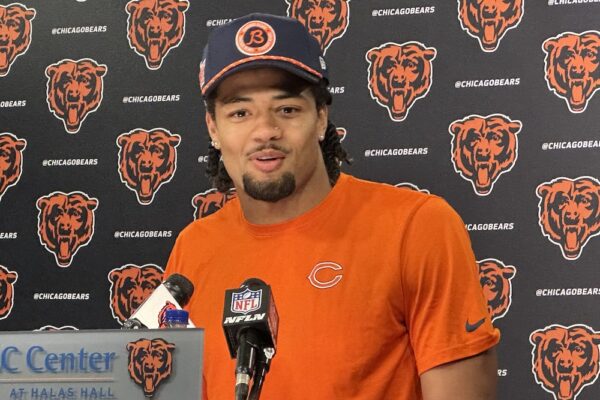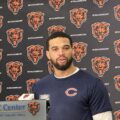
At the midway point of the 2020 MLB season, the Chicago Cubs are 18-12 and in first place of the NL Central, three games ahead of the St. Louis Cardinals, who, at 11-11, are still in the process of making up ground after rescheduling several games from Coronavirus positives. The MLB season has marched on, however, and with the Cubs sitting pretty in first place, now is a good time to issue the report card on the 2020 Cubs
Starting rotation: B+
Easily their strongest group, the Cubs’ rotation had been this year, up until the last couple weeks, when it’s returned back to Earth. After a blazing start to the season, with three starters with sub-two ERAs after multiple starts, the rotation sustained a number of tough outings from their starters. Since August, they’ve been above average in starters’ ERA with the 13th lowest ERA, but that number has ballooned in the last two weeks; since August 14, the Cubs have put up a 5.38 ERA from their starters, are burdened by brutal outings like Jon Lester’s August 21 performance (Eight earned runs in 3.2 innings 21 against the White Sox), Alec Mill’s 3.2-inning outing where he allowed six earned runs on August 19 and Tyler Chatwood not getting out of the first inning August 25 against the Tigers in a 7-1 loss.
But it’s fair to wonder that the last two weeks are outliers in a wholistic assessment of the season. Lester got right back on track in his next start, going five innings and allowing one earned run in Wednesday’s 7-6 loss to the Tigers. Apart from his August 16 start in which he allowed five earned runs in six innings, he hasn’t allowed more than one earned run in any other start. He’s not going to be that good every start, but he probably won’t be that bad either.
Alec Mills has been the typical back-end starter, dependable for a decent start with and capable of both of great or bad outings. José Quintana’s return should also provide further stability and potentially move Chatwood into the bullpen, where he’s been effective. Kyle Hendricks, with a 3.55 ERA, has been a beacon of consistency since August.
The story for the Cubs’ rotation has been Yu Darvish, who has been simply brilliant. Currently tied with Jacob deGrom for second-best odds to win NL Cy Young at +500, he has the fifth-lowest ERA in baseball at 1.70 and backs it up with a 2.13 FIP, also the fifth lowest. His K/9 ranks 11th in baseball and his walk rate is fifth lowest (1.46 BB/9, behind Lester and Hendricks, respectively). He stopped the bleeding on Sunday after the Cubs allowed 17 earned runs in their previous two games against the White Sox by striking out 10 and allowing one earned run in seven innings.
At some point in 2018 and for much of 2019 Darvish was seen as a sunken cost, yet another swing-and-miss by the Cubs’ front office. But he’s been the best player on their roster this year. If not for his revitalization, the Cubs would be in a much murkier position with their rotation and with their team. If it weren’t for the past two weeks this grade would be in the As, but after a couple rough outings, B+ is where they stand
Bullpen: D+
As a whole things need to improve for the Cubs’ bullpen. They have the third-highest ERA in baseball among relievers, the fourth highest HR/9 and the fifth-highest BB/9.

The bullpen has stayed somewhat above water thanks to contributions from select players. Jeremy Jeffress has once again looked like the closer he was in 2018, allowing only two earned runs in 12.1 innings while collecting three saves. Apart from Jeffress, however, manager David Ross doesn’t have much to pick from. There was a point in August where the group seemed together, but there was a tenuous feeling to how long that would last. Rowan Wick, who was possibly the most reliable option available earlier in the year, has fallen on some difficult outings, allowing four earned runs in his last two innings. He’s allowed a .177 wOBA in what Fangraphs considers high-leverage situations, so he hasn’t had a late-game blowup and may be due for positive regression if these last two appearances are truly out of the norm for this season, but the steps back he’s taken are a problem for the Cubs. He and Jeffress were the closest thing to a sure thing the Cubs had, and now it looks like only Jeffress is in that category. Craig Kimbrel is slowly coming along but he has yet to prove his chops in truly momentous appearances. Adbert Alzolay is young but has looked good in brief appearances and Chatwood, Mills or Quintana entering the bullpen full-time could offer some relief, but the group is not in a good spot right now
The Cubs will at least look at what’s out there to upgrade their bullpen, but baseball’s trade deadline is weird this year. Scouts aren’t in stands and teams have a harder time than usual of knowing where they stand as contenders, not to mention the Cubs’ tight budget. Whatever Theo Epstein does at the trade deadline, he’ll probably have to be creative.
Lineup: B-
This grade floated between B and B-, but ultimately the latter prevailed. The Cubs’ offense has been… average, with most of the contribution coming from their outfielders. Ian Happ is the name that jumps off the page, who has simply been their best hitter this whole year. He leads the team in ISO, wOBA, wRC+, OBP, slugging and batting average. He’s tied with Kyle Schwarber for the lead in home runs with six and has taken over the centerfield spot seemingly for good. Schwarber, for his part, has been the solid power-hitter he’s long beenadvertised as with a .440 slugging, fourth on the team. Who’s directly in front of him? Jason Heyward, who has quietly had one of his best hitting years as a Cub, with a slash line of .264/.372/.458. His power numbers are backed up by a solid .194 ISO. They don’t have much else in the way of a fourth outfielder, as Steve Souza Jr. has yet to make an impact, so they will likely look for an upgrade. But for now, the Cubs have relied on the offense of their three main outfielders.

It’s the infield, where the Cubs’ “core” stars play, that has lagged. Kris Bryant, Javier Báez and Willson Contreras, specifically, have not performed to their true capabilities. Together, those three are hitting .202, with Bryant at an extremely out of character .177 batting average. He’s taken time off with a wrist injury and his return to health may give a jump to the lineup, but that’s still in wait-and-see mode. Anthony Rizzo has slugged only .382, despite hitting five home runs on the year. Jason Kipnis has far exceeded his production expectations with 149 wRC+, second-most on the team, but in only 63 at-bats.
The Cubs are 16th in home runs, 17th in runs and 13th in wOBA and are seventh in OBP and third in BB%. But at the same time, they’re 22nd in slugging, have the fourth highest K%. They can’t afford to be average in some spots and bad in others, they need to be great in some and average in others to truly battle for a World Series. We can take an optimistic perspective and say that their stars are due for some production and things will rev back up for the team as a whole. The pessimist perspective is… well, you can decide for yourself.
Prediction for the end of season: NL Central champs
With the Cubs’ current standing in their division, it’s almost impossible they’ll miss the playoffs. FanGraphs gives them a 95.3% chance at making the playoffs and a 69.1% chance to win their division. But right now, they are a team with holes. The rotation is not free of blemishes, despite a strong start and only recent trip-ups, their bullpen is still a problem and we have yet to see the lineup perform up to its full potential. This is a team that can and likely will win their division. But the only question that matters in the playoffs, for NL teams especially, is if they can beat the Dodgers. At this point, that doesn’t seem likely.









